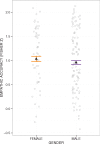Neural correlates of empathic accuracy in adolescence
- PMID: 28981837
- PMCID: PMC5714170
- DOI: 10.1093/scan/nsx099
Neural correlates of empathic accuracy in adolescence
Abstract
Empathy, the ability to understand others' emotions, can occur through perspective taking and experience sharing. Neural systems active when adults empathize include regions underlying perspective taking (e.g. medial prefrontal cortex; MPFC) and experience sharing (e.g. inferior parietal lobule; IPL). It is unknown whether adolescents utilize networks implicated in both experience sharing and perspective taking when accurately empathizing. This question is critical given the importance of accurately understanding others' emotions for developing and maintaining adaptive peer relationships during adolescence. We extend the literature on empathy in adolescence by determining the neural basis of empathic accuracy, a behavioral assay of empathy that does not bias participants toward the exclusive use of perspective taking or experience sharing. Participants (N = 155, aged 11.1-15.5 years) watched videos of 'targets' describing emotional events and continuously rated the targets' emotions during functional magnetic resonance imaging scanning. Empathic accuracy related to activation in regions underlying perspective taking (MPFC, temporoparietal junction and superior temporal sulcus), while activation in regions underlying experience sharing (IPL, anterior cingulate cortex and anterior insula) related to lower empathic accuracy. These results provide novel insight into the neural basis of empathic accuracy in adolescence and suggest that perspective taking processes may be effective for increasing empathy.
Keywords: adolescence; empathic accuracy; empathy; experience sharing; perspective taking.
© The Author (2017). Published by Oxford University Press.
Figures




Similar articles
-
Tracking emotions in the brain - Revisiting the Empathic Accuracy Task.Neuroimage. 2018 Sep;178:677-686. doi: 10.1016/j.neuroimage.2018.05.080. Epub 2018 Jun 8. Neuroimage. 2018. PMID: 29890323 Free PMC article.
-
Can people empathize with offenders and victims during violent scenes? Behavioral and brain correlates of affective and cognitive empathy considering victim vs. offender perspective using the Bochumer affective and cognitive empathy task (BACET).Neuropsychologia. 2024 Feb 15;194:108784. doi: 10.1016/j.neuropsychologia.2023.108784. Epub 2023 Dec 28. Neuropsychologia. 2024. PMID: 38159801
-
Emotional engagement with close friends in adolescence predicts neural correlates of empathy in adulthood.Soc Neurosci. 2024 Aug;19(4):246-258. doi: 10.1080/17470919.2024.2406863. Epub 2024 Sep 26. Soc Neurosci. 2024. PMID: 39324514
-
The neural bases for empathy.Neuroscientist. 2011 Feb;17(1):18-24. doi: 10.1177/1073858410379268. Epub 2010 Nov 11. Neuroscientist. 2011. PMID: 21071616 Review.
-
A developmental perspective on the neural bases of human empathy.Infant Behav Dev. 2017 Aug;48(Pt A):5-12. doi: 10.1016/j.infbeh.2015.11.006. Epub 2016 Mar 17. Infant Behav Dev. 2017. PMID: 26995647 Review.
Cited by
-
Resting-state connectivity underlying cognitive control's association with perspective taking in callous-unemotional traits.Psychiatry Res Neuroimaging. 2023 Jun;331:111615. doi: 10.1016/j.pscychresns.2023.111615. Epub 2023 Mar 3. Psychiatry Res Neuroimaging. 2023. PMID: 36924739 Free PMC article.
-
Empathic Accuracy in Adolescent Girls with Turner Syndrome.J Autism Dev Disord. 2022 May;52(5):2203-2212. doi: 10.1007/s10803-021-05089-3. Epub 2021 Jun 3. J Autism Dev Disord. 2022. PMID: 34081302 Free PMC article.
-
Wellbeing skills strengthening as a model for healthy adolescent digital technology use.Ann N Y Acad Sci. 2025 Aug;1550(1):5-13. doi: 10.1111/nyas.15414. Epub 2025 Jul 29. Ann N Y Acad Sci. 2025. PMID: 40729672 Free PMC article. Review.
-
Callous-unemotional traits in adolescents moderate neural network associations with empathy.Psychiatry Res Neuroimaging. 2022 Mar;320:111429. doi: 10.1016/j.pscychresns.2021.111429. Epub 2021 Dec 20. Psychiatry Res Neuroimaging. 2022. PMID: 34968822 Free PMC article.
-
Network functional connectivity underlying dissociable cognitive and affective components of empathy in adolescence.Neuropsychologia. 2021 Jun 18;156:107832. doi: 10.1016/j.neuropsychologia.2021.107832. Epub 2021 Mar 19. Neuropsychologia. 2021. PMID: 33753085 Free PMC article.
References
-
- Allison T., Puce A., McCarthy G. (2000). Social perception from visual cues: role of the STS region. Trends in Cognitive Sciences, 4, 267–78. - PubMed
-
- Baron-Cohen S., Jolliffe T., Mortimore C., Robertson M. (1997). Another advanced test of theory of mind: evidence from very high functioning adults with autism or Asperger syndrome. Journal of Child Psychology and Psychiatry, 38, 813–22. - PubMed
-
- Bates D., Machler M., Bolker B., Walker S. (2015). Fitting linear mixed-effects models using lme4. Journal of Statistical Software, 67(1), 1–48.
-
- Blakemore S.-J. (2008). The social brain in adolescence. Nature Reviews. Neuroscience, 9, 267–77. - PubMed
-
- Blakemore S.-J. (2012). Imaging brain development: the adolescent brain. NeuroImage, 61, 397–406. - PubMed
MeSH terms
Grants and funding
LinkOut - more resources
Full Text Sources
Other Literature Sources
Medical

